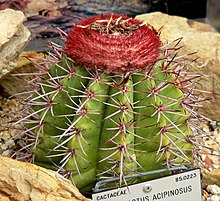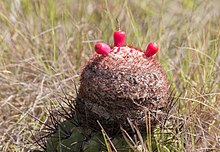Melocactus
| Melocactus | |
|---|---|

| |
| M. acipinosus | |
| Scientific classification | |
| Kingdom: | Plantae |
| Clade: | Tracheophytes |
| Clade: | Angiosperms |
| Clade: | Eudicots |
| Order: | Caryophyllales |
| Family: | Cactaceae |
| Subfamily: | Cactoideae |
| Subtribe: | Cereinae |
| Genus: | Melocactus Link & Otto |
| Species | |
Melocactus (melon cactus), also known as the Turk's cap cactus, is a genus of cactus with about 30–40 species. They are native to the Caribbean, western Mexico through Central America to northern South America, with some species along the Andes down to southern Peru, and a concentration of species in northeastern Brazil.[1]
The first species was named by Carl Linnaeus in 1753, as Cactus melocactus. When the genus was separated from Cactus, the pre-Linnaean name Melocactus was used. Acting on the principle of priority, in 1922 Nathaniel Britton and Joseph Rose resurrected Linnaeus' Cactus. However, the 1905 Vienna botanical congress had already rejected the name Cactus, so this name was not available, and Melocactus Link & Otto is the correct genus name.[1]

Mature plants are easily recognizable by their cephalium, a wool- and bristle-coated structure at the apex of the plant, containing a mass of areoles from which the small flowers grow.[1] Since the red, wool-coated cephalium of the plant is similar to the Fez hat of the Turkish male citizens during late Ottoman Empire, one name for the plant is Turk's cap cactus.[2][3]
The fruits of Melocactus are pink and resemble the shape of pepper fruits. The fruits of this genus are edible, and in the wild they are frequently dispersed by lizards and birds.[4]
Species
As of February 2020[update], Plants of the World Online accepted the following species:[5]
- Melocactus × albicephalus Buining & Brederoo
- Melocactus andinus R.Gruber ex N.P.Taylor
- Melocactus azureus Buining & Brederoo
- Melocactus bahiensis (Britton & Rose) Luetzelb.
- Melocactus bellavistensis Rauh & Backeb.
- Melocactus braunii Esteves
- Melocactus brederooianus Buining
- Melocactus broadwayi (Britton & Rose) A.Berger
- Melocactus caroli-linnaei N.P.Taylor
- Melocactus conoideus Buining & Brederoo
- Melocactus curvispinus Pfeiff.
- Melocactus deinacanthus Buining & Brederoo
- Melocactus ernestii Vaupel
- Melocactus estevesii P.J.Braun
- Melocactus ferreophilus Buining & Brederoo
- Melocactus glaucescens Buining & Brederoo
- Melocactus harlowii (Britton & Rose) Vaupel
- Melocactus × horridus Werderm.
- Melocactus inconcinnus Buining & Brederoo
- Melocactus intortus (Mill.) Urb.
- Melocactus lanssensianus P.J.Braun
- Melocactus lemairei (Monv. ex Lem.) Miq. ex Lem.
- Melocactus levitestatus Buining & Brederoo
- Melocactus macracanthos (Salm-Dyck) Link & Otto
- Melocactus matanzanus León
- Melocactus mazelianus Ríha
- Melocactus neryi K.Schum.
- Melocactus oreas Miq.
- Melocactus pachyacanthus Buining & Brederoo
- Melocactus paucispinus Heimen & R.J.Paul
- Melocactus peruvianus Vaupel
- Melocactus pruinosus Werderm.
- Melocactus salvadorensis Werderm.
- Melocactus schatzlii H.Till & R.Gruber
- Melocactus sergipensis N.P.Taylor & Meiado
- Melocactus smithii (Alexander) Buining ex G.D.Rowley
- Melocactus stramineus Suringar
- Melocactus violaceus Pfeiff.
- Melocactus zehntneri (Britton & Rose) Luetzelb.
References
- ^ a b c Anderson, Edward F. (2001), The Cactus Family, Pentland, Oregon: Timber Press, ISBN 978-0-88192-498-5, pages=456–467
- ^ [1] Archived June 9, 2010, at the Wayback Machine
- ^ "Coastal Lake-Sediment Records of Prehistoric Hurricane Strikes in Honduras and Turks and Caicos Islands of the Caribbean Basin" (PDF). googleusercontent.com. Archived from the original on 2010-07-19.
{{cite web}}: CS1 maint: bot: original URL status unknown (link) - ^ Thomson, George (2008). Melocactus: care and cultivation. p. 13.
- ^ "Melocactus Link & Otto". Plants of the World Online. Royal Botanic Gardens, Kew. Retrieved 2020-02-16.
